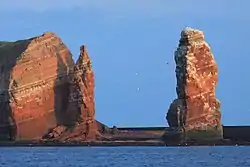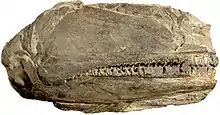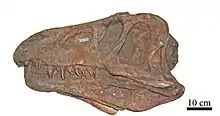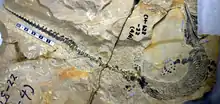Olenekian
In the geologic timescale, the Olenekian is an age in the Early Triassic epoch; in chronostratigraphy, it is a stage in the Lower Triassic series. It spans the time between 251.2 Ma and 247.2 Ma (million years ago).[7] The Olenekian is sometimes divided into the Smithian and the Spathian subages or substages.[8] The Olenekian follows the Induan and is followed by the Anisian (Middle Triassic).[9]
| Olenekian | |||||||||||||||||||||||
|---|---|---|---|---|---|---|---|---|---|---|---|---|---|---|---|---|---|---|---|---|---|---|---|
 | |||||||||||||||||||||||
| Chronology | |||||||||||||||||||||||
| |||||||||||||||||||||||
| Etymology | |||||||||||||||||||||||
| Name formality | Formal | ||||||||||||||||||||||
| Usage information | |||||||||||||||||||||||
| Celestial body | Earth | ||||||||||||||||||||||
| Regional usage | Global (ICS) | ||||||||||||||||||||||
| Time scale(s) used | ICS Time Scale | ||||||||||||||||||||||
| Definition | |||||||||||||||||||||||
| Chronological unit | Age | ||||||||||||||||||||||
| Stratigraphic unit | Stage | ||||||||||||||||||||||
| Time span formality | Formal | ||||||||||||||||||||||
| Lower boundary definition | Not formally defined | ||||||||||||||||||||||
| Lower boundary definition candidates | FAD of the Conodont Neospathodus waageni | ||||||||||||||||||||||
| Lower boundary GSSP candidate section(s) | Mud (Muth) village, Spiti valley, India[6] | ||||||||||||||||||||||
| Upper boundary definition | Not formally defined | ||||||||||||||||||||||
| Upper boundary definition candidates |
| ||||||||||||||||||||||
| Upper boundary GSSP candidate section(s) |
| ||||||||||||||||||||||
The Olenekian saw the deposition of a large part of the Buntsandstein in Europe. The Olenekian is roughly coeval with the regional Yongningzhenian Stage used in China.
Stratigraphic definitions
The Olenekian Stage was introduced into scientific literature by Russian stratigraphers in 1956.[10] The stage is named after Olenëk in Siberia. Before the subdivision in Olenekian and Induan became established, both stages formed the Scythian Stage, which has since disappeared from the official timescale.
The base of the Olenekian is at the lowest occurrence of the ammonoids Hedenstroemia or Meekoceras gracilitatis, and of the conodont Neospathodus waageni. It is defined as ending near the lowest occurrences of genera Japonites, Paradanubites, and Paracrochordiceras; and of the conodont Chiosella timorensis. A GSSP (global reference profile for the base) has not been established as of December 2020.
In the 1960s, English paleontologist Edward T. Tozer (sometimes collaborating with American geologist Norman J. Silberling) crafted Triassic timescales based on North American ammonoid zones, further refining it in the following decades. Tozer's nomenclature was largely derived from Mojsisovics's work, who coined most of the Triassic stages and substages, but he redefined them using North American sites. He recommended the Lower Triassic series be divided into the Griesbachian, Dienerian, Smithian, and Spathian. The latter two roughly correspond with the Olenekian. Tozer's timescale became popular in the Americas.[11] He named the Smithian after Smith Creek on Ellesmere Island, Canada (the creek itself is named after geologist J. P. Smith). The Smithian is defined by the Arctoceras bloomstrandi ammonoid zone (contains Euflemingites romunderi and Juvenites crassus) and the overlying Meekoceras gracilitatis and Wasatchites tardus subzones. He named the Spathian after Spath Creek on Ellesmere Island (this creek is named after geologist L. F. Spath), and defined it by the Procolumbites subrobustus ammonoid zone.[8]
Olenekian life
Life was still recovering from the severe end-Permian mass extinction. During the Olenekian, the flora changed from lycopod dominated (e.g. Pleuromeia) to gymnosperm and pteridophyte dominated.[12][13] These vegetation changes are due to global changes in temperature and precipitation. Conifers (gymnosperms) were the dominant plants during most of the Mesozoic. Among land vertebrates, the archosaurs - a group of diapsid reptiles encompassing crocodiles, pterosaurs, dinosaurs, and ultimately birds - first evolved from archosauriform ancestors during the Olenekian. This group includes ferocious predators like Erythrosuchus.
In the oceans, microbial reefs were common during the Early Triassic, possibly due to lack of competition with metazoan reef builders as a result of the extinction.[14] However, transient metazoan reefs reoccurred during the Olenekian wherever permitted by environmental conditions.[15] Ammonoids and conodonts diversified, but both suffered losses during the Smithian-Spathian boundary extinction[16] at the end of the Smithian subage.
Ray-finned fishes largely remained unaffected by the Permian-Triassic extinction event.[17][18] Many genera show a cosmopolitan (worldwide) distribution during the Induan and Olenekian (e.g. Australosomus, Birgeria, Parasemionotidae, Pteronisculus, Ptycholepidae, Saurichthys). This is well exemplified in the Griesbachian (early Induan) aged fish assemblages of the Wordie Creek Formation (East Greenland), the Dienerian (late Induan) aged assemblages of the Sakamena Formation (Madagascar), Candelaria Formation (Nevada, United States), and Mikin Formation (Himachal Pradesh, India), and the Smithian aged assemblages of the Vikinghøgda Formation (Spitsbergen, Norway), Thaynes Formation (western United States), and Helongshan Formation (Anhui, China). Ray-finned fishes diversified during the Triassic and reached peak diversity during the Middle Triassic. This diversification is, however, obscured by a taphonomic megabias during the late Olenekian and early middle Anisian.[19]
Marine temnospondyl amphibians, such as the superficially crocodile-shaped trematosaurids Aphaneramma and Wantzosaurus, show wide geographic ranges during the Induan and Olenekian ages. Their fossils are found in Greenland, Spitsbergen, Pakistan and Madagascar.[20] Others, such as Trematosaurus, inhabited freshwater environments and were less widespread.
The first marine reptiles appeared during the Olenekian.[20] Hupehsuchia, Ichthyopterygia and Sauropterygia are among the first marine reptiles to enter the scene (e.g. Cartorhynchus, Chaohusaurus, Utatsusaurus, Hupehsuchus, Grippia, Omphalosaurus, Corosaurus). Sauropterygians and ichthyosaurs ruled the oceans during the Mesozoic Era.
An example of an exceptionally diverse Early Triassic assemblage is the Paris biota, fossils of which were discovered near Paris, Idaho[21] and other nearby sites in Idaho and Nevada.[22] The Paris Biota was deposited in the wake of the SSBM and it features at least 7 phyla and 20 distinct metazoan orders, including leptomitid protomonaxonid sponges (previously only known from the Paleozoic), thylacocephalans, crustaceans, nautiloids, ammonoids, coleoids, ophiuroids, crinoids, and vertebrates.[23] Such diverse assemblages show that organisms diversified wherever and whenever climatic an environmental conditions ameliorated.
 Life restoration of Pleuromeia, a genus of lycophyte that was globally abundant during the Olenekinian
Life restoration of Pleuromeia, a genus of lycophyte that was globally abundant during the Olenekinian Skull of the ray-finned fish Birgeria americana
Skull of the ray-finned fish Birgeria americana Skull of the temnospondyl amphibian Trematosaurus brauni
Skull of the temnospondyl amphibian Trematosaurus brauni Skull of the archosauriform reptile Erythrosuchus africanus
Skull of the archosauriform reptile Erythrosuchus africanus Marine ichthyosauromorph reptile Chaohusaurus
Marine ichthyosauromorph reptile Chaohusaurus
Smithian–Spathian boundary event

An important extinction event occurred during the Olenekian age of the Early Triassic, near the Smithian and Spathian subage boundary. The main victims of this Smithian–Spathian boundary event, often called the Smithian–Spathian extinction,[25] were 'disaster taxa': Palaeozoic species that survived the Permian–Triassic extinction event and flourished in the immediate aftermath of the extinction;[26] ammonoids, conodonts, and radiolarians in particular suffered drastic biodiversity losses.[27][26] Marine reptiles, such as ichthyopterygians and sauropterygians, diversified after the extinction.
The flora was also affected significantly. It changed from lycopod dominated (e.g. Pleuromeia) during the Dienerian and Smithian subages to gymnosperm and pteridophyte dominated in the Spathian.[28][29] These vegetation changes are due to global changes in temperature and precipitation. Conifers (gymnosperms) were the dominant plants during most of the Mesozoic. Until recently the existence of this extinction event about 249.4 Ma ago[30] was not recognised.[31]
The Smithian–Spathian boundary extinction was linked to late eruptions of the Siberian Traps,[32] which released warming greenhouse gases, resulting in climate change[33] and in acidification, both on land[34] and in the ocean.[35] A large spike in mercury concentrations relative to total organic carbon, much like during the Permian-Triassic extinction, has been suggested as another contributor to the extinction,[36] although this is controversial and has been disputed by other research that suggests elevated mercury levels already existed by the middle Spathian.[37] Prior to the Smithian-Spathian Boundary extinction event, a flat gradient of latitudinal species richness is observed, suggesting that warmer temperatures extended into higher latitudes, allowing extension of geographic ranges of species adapted to warmer temperatures, and displacement or extinctions of species adapted to cooler temperatures.[38] Oxygen isotope studies on conodonts have revealed that temperatures rose in the first 2 million years of the Triassic, ultimately reaching sea surface temperatures of up to 40 °C (104 °F) in the tropics during the Smithian.[39] The extinction itself occurred during a subsequent drop in global temperatures (ca. 8°C over a geologically short period) in the latest Smithian; however, temperature alone cannot account for the Smithian-Spathian boundary extinction, because several factors were at play.[40][41] An alternative explanation for the extinction event hypothesises the biotic crisis took place not at the Smithian-Spathian boundary but shortly before, during the Late Smithian Thermal Maximum (LSTM), with the Smithian-Spathian boundary itself being associated with cessation of intrusive magmatic activity of the Siberian Traps,[42] along with significant global cooling,[43][44] after which a gradual biotic recovery took place over the early and middle Spathian,[42] along with a decline in continental weathering[45] and a rejuvenation of ocean circulation.[46]
In the ocean, many large and mobile species moved away from the tropics, but large fish remained,[47] and amongst the immobile species such as molluscs, only the ones that could cope with the heat survived; half the bivalves disappeared.[48] Conodonts decreased in average size as a result of the extinction.[49] On land, the tropics were nearly devoid of life,[50] with exceptionally arid conditions recorded in Iberia and other parts of Europe then at low latitude.[51] Many big, active animals returned to the tropics, and plants recolonised on land, only when temperatures returned to normal.
There is evidence that life had recovered rapidly, at least locally. This is indicated by sites that show exceptionally high biodiversity (e.g. the earliest Spathian Paris Biota),[52][53] which suggest that food webs were complex and comprised several trophic levels.
Notable formations
- Middle Buntsandstein (Germany)
- Cynognathus Assemblage Zone / Burgersdorp Formation (subzones A-B)* (South Africa)
- Lower Ermaying Formation* (Shaanxi and Shanxi, China)
- Upper Fremouw Formation* (Antarctica)
- Jialingjiang Formation (South China)
- Moenkopi Formation (Torrey and Wutapki members)* (SW USA)
- Nanlinghu Formation (Anhui, China)
- Rybinskian Gorizont* (European Russia)
- Sanga do Cabral Formation* (Rio Grande do Sul, Brazil)
- Sludkian Gorizont* (European Russia)
- Sulphur Mountain Formation (British Columbia, Canada)
- Thaynes Group/Limestone (western USA)
- Ustmylian Gorizont* (European Russia)
- Virgin Formation (Utah, USA)
- Vikinghøgda Formation (Lusitaniadalen and Vendomdalen members) (Svalbard, Norway)
- Yarenskian Gorizont* (European Russia)
* Tentatively assigned to the Olenekian; age estimated primarily via terrestrial tetrapod biostratigraphy (see Triassic land vertebrate faunachrons)
References
Notes
- Widmann, Philipp; Bucher, Hugo; Leu, Marc; et al. (2020). "Dynamics of the Largest Carbon Isotope Excursion During the Early Triassic Biotic Recovery". Frontiers in Earth Science. 8 (196): 196. Bibcode:2020FrEaS...8..196W. doi:10.3389/feart.2020.00196.
- McElwain, J. C.; Punyasena, S. W. (2007). "Mass extinction events and the plant fossil record". Trends in Ecology & Evolution. 22 (10): 548–557. doi:10.1016/j.tree.2007.09.003. PMID 17919771.
- Retallack, G. J.; Veevers, J.; Morante, R. (1996). "Global coal gap between Permian–Triassic extinctions and middle Triassic recovery of peat forming plants". GSA Bulletin. 108 (2): 195–207. Bibcode:1996GSAB..108..195R. doi:10.1130/0016-7606(1996)108<0195:GCGBPT>2.3.CO;2. Retrieved 2007-09-29.
- Payne, J. L.; Lehrmann, D. J.; Wei, J.; Orchard, M. J.; Schrag, D. P.; Knoll, A. H. (2004). "Large Perturbations of the Carbon Cycle During Recovery from the End-Permian Extinction". Science. 305 (5683): 506–9. Bibcode:2004Sci...305..506P. doi:10.1126/science.1097023. PMID 15273391. S2CID 35498132.
- Ogg, James G.; Ogg, Gabi M.; Gradstein, Felix M. (2016). "Triassic". A Concise Geologic Time Scale: 2016. Elsevier. pp. 133–149. ISBN 978-0-444-63771-0.
- "Global Boundary Stratotype Section and Point". International Commission of Stratigraphy. Retrieved 23 December 2020.
- According to Gradstein (2004). Brack et al. (2005) give 251 to 248 Ma
- Tozer, E. T. (1965). "Lower Triassic stages and ammonoid zones of Arctic Canada". Geological Survey of Canada Paper. 65–12: 1–14. doi:10.4095/100985.
- See for a detailed geologic timescale Gradstein et al. (2004)
- Kiparisova & Popov (1956)
- Lucas, S. G. (2010). "The Triassic chronostratigraphic scale: history and status". Geological Society, London, Special Publications. 334 (1): 17–39. Bibcode:2010GSLSP.334...17L. doi:10.1144/sp334.2. S2CID 129648527.
- Schneebeli-Hermann, Elke; Kürschner, Wolfram M.; Kerp, Hans; Bomfleur, Benjamin; Hochuli, Peter A.; Bucher, Hugo; Ware, David; Roohi, Ghazala (April 2015). "Vegetation history across the Permian–Triassic boundary in Pakistan (Amb section, Salt Range)". Gondwana Research. 27 (3): 911–924. Bibcode:2015GondR..27..911S. doi:10.1016/j.gr.2013.11.007.
- Goudemand, Nicolas; Romano, Carlo; Leu, Marc; Bucher, Hugo; Trotter, Julie A.; Williams, Ian S. (August 2019). "Dynamic interplay between climate and marine biodiversity upheavals during the early Triassic Smithian -Spathian biotic crisis". Earth-Science Reviews. 195: 169–178. Bibcode:2019ESRv..195..169G. doi:10.1016/j.earscirev.2019.01.013.
- Foster, William J.; Heindel, Katrin; Richoz, Sylvain; Gliwa, Jana; Lehrmann, Daniel J.; Baud, Aymon; Kolar‐Jurkovšek, Tea; Aljinović, Dunja; Jurkovšek, Bogdan; Korn, Dieter; Martindale, Rowan C.; Peckmann, Jörn (20 November 2019). "Suppressed competitive exclusion enabled the proliferation of Permian/Triassic boundary microbialites". The Depositional Record. 6 (1): 62–74. doi:10.1002/dep2.97. PMC 7043383. PMID 32140241.
- Brayard, Arnaud; Vennin, Emmanuelle; Olivier, Nicolas; Bylund, Kevin G.; Jenks, Jim; Stephen, Daniel A.; Bucher, Hugo; Hofmann, Richard; Goudemand, Nicolas; Escarguel, Gilles (18 September 2011). "Transient metazoan reefs in the aftermath of the end-Permian mass extinction". Nature Geoscience. 4 (10): 693–697. Bibcode:2011NatGe...4..693B. doi:10.1038/ngeo1264.
- Galfetti, Thomas; Hochuli, Peter A.; Brayard, Arnaud; Bucher, Hugo; Weissert, Helmut; Vigran, Jorunn Os (2007). "Smithian-Spathian boundary event: Evidence for global climatic change in the wake of the end-Permian biotic crisis". Geology. 35 (4): 291. Bibcode:2007Geo....35..291G. doi:10.1130/G23117A.1.
- Romano, Carlo; Koot, Martha B.; Kogan, Ilja; Brayard, Arnaud; Minikh, Alla V.; Brinkmann, Winand; Bucher, Hugo; Kriwet, Jürgen (February 2016). "Permian-Triassic Osteichthyes (bony fishes): diversity dynamics and body size evolution". Biological Reviews. 91 (1): 106–147. doi:10.1111/brv.12161. PMID 25431138. S2CID 5332637.
- Smithwick, Fiann M.; Stubbs, Thomas L. (2 February 2018). "Phanerozoic survivors: Actinopterygian evolution through the Permo‐Triassic and Triassic‐Jurassic mass extinction events". Evolution. 72 (2): 348–362. doi:10.1111/evo.13421. PMC 5817399. PMID 29315531.
- Romano, Carlo (January 2021). "A Hiatus Obscures the Early Evolution of Modern Lineages of Bony Fishes". Frontiers in Earth Science. 8: 618853. doi:10.3389/feart.2020.618853.
- Scheyer, Torsten M.; Romano, Carlo; Jenks, Jim; Bucher, Hugo; Farke, Andrew A. (19 March 2014). "Early Triassic Marine Biotic Recovery: The Predators' Perspective". PLOS ONE. 9 (3): e88987. Bibcode:2014PLoSO...988987S. doi:10.1371/journal.pone.0088987. PMC 3960099. PMID 24647136.
- Brayard, Arnaud; Krumenacker, L. J.; Botting, Joseph P.; Jenks, James F.; Bylund, Kevin G.; Fara, Emmanuel; Vennin, Emmanuelle; Olivier, Nicolas; Goudemand, Nicolas; Saucède, Thomas; Charbonnier, Sylvain; Romano, Carlo; Doguzhaeva, Larisa; Thuy, Ben; Hautmann, Michael; Stephen, Daniel A.; Thomazo, Christophe; Escarguel, Gilles (15 February 2017). "Unexpected Early Triassic marine ecosystem and the rise of the Modern evolutionary fauna". Science Advances. 3 (2): e1602159. Bibcode:2017SciA....3E2159B. doi:10.1126/sciadv.1602159. PMC 5310825. PMID 28246643.
- Smith, Christopher P.A.; Laville, Thomas; Fara, Emmauel; Escarguel, Gilles; Olivier, Nicolas; Vennin, Emmanuelle; Goudemand, Nicolas; Bylund, Kevin G.; Jenks, James F.; Stephen, Daniel A.; Hautmann, Michael; Charbonnier, Sylvain; Krumenacker, L. J.; Brayard, Arnaud (4 October 2021). "Exceptional fossil assemblages confirm the existence of complex Early Triassic ecosystems during the early Spathian". Scientific Reports. 11 (1): 19657. Bibcode:2021NatSR..1119657S. doi:10.1038/s41598-021-99056-8. PMC 8490361. PMID 34608207.
- Special issue on Paris Biota: https://www.sciencedirect.com/journal/geobios/vol/54
- Scheyer, Torsten M.; Romano, Carlo; Jenks, Jim; Bucher, Hugo (19 March 2014). "Early Triassic Marine Biotic Recovery: The Predators' Perspective". PLOS ONE. 9 (3): e88987. Bibcode:2014PLoSO...988987S. doi:10.1371/journal.pone.0088987. PMC 3960099. PMID 24647136.
- Galfetti, Thomas; Hochuli, Peter A.; Brayard, Arnaud; Bucher, Hugo; Weissert, Helmut; Vigran, Jorunn Os (2007). "Smithian-Spathian boundary event: Evidence for global climatic change in the wake of the end-Permian biotic crisis". Geology. 35 (4): 291. Bibcode:2007Geo....35..291G. doi:10.1130/G23117A.1.
- Sun, Y. D.; Wignall, Paul B.; Joachimski, M. M.; Bond, David P. G.; Grasby, S. E.; Sun, S.; Yan, C. B.; Wang, L. N.; Chen, Y. L.; Lai, X. L. (1 June 2015). "High amplitude redox changes in the late Early Triassic of South China and the Smithian–Spathian extinction". Palaeogeography, Palaeoclimatology, Palaeoecology. 427: 62–78. Bibcode:2015PPP...427...62S. doi:10.1016/j.palaeo.2015.03.038. Retrieved 12 December 2022.
- Zhang, Lei; Orchard, Michael J.; Brayard, Arnaud; Algeo, Thomas J.; Zhao, Laishi; Chen, Zhong-Qiang; Lyu, Zhengyi (August 2019). "The Smithian/Spathian boundary (late Early Triassic): A review of ammonoid, conodont, and carbon-isotopic criteria". Earth-Science Reviews. 195: 7–36. Bibcode:2019ESRv..195....7Z. doi:10.1016/j.earscirev.2019.02.014. S2CID 134513553. Retrieved 12 December 2022.
- Schneebeli-Hermann, Elke; Kürschner, Wolfram M.; Kerp, Hans; Bomfleur, Benjamin; Hochuli, Peter A.; Bucher, Hugo; Ware, David; Roohi, Ghazala (April 2015). "Vegetation history across the Permian–Triassic boundary in Pakistan (Amb section, Salt Range)". Gondwana Research. 27 (3): 911–924. Bibcode:2015GondR..27..911S. doi:10.1016/j.gr.2013.11.007.
- Goudemand, Nicolas; Romano, Carlo; Leu, Marc; Bucher, Hugo; Trotter, Julie A.; Williams, Ian S. (August 2019). "Dynamic interplay between climate and marine biodiversity upheavals during the early Triassic Smithian -Spathian biotic crisis". Earth-Science Reviews. 195: 169–178. Bibcode:2019ESRv..195..169G. doi:10.1016/j.earscirev.2019.01.013.
- Widmann, Philipp; Bucher, Hugo; Leu, Marc; Vennemann, Torsten; Bagherpour, Borhan; Schneebeli-Hermann, Elke; Goudemand, Nicolas; Schaltegger, Urs (2020). "Dynamics of the Largest Carbon Isotope Excursion During the Early Triassic Biotic Recovery". Frontiers in Earth Science. 8 (196): 196. Bibcode:2020FrEaS...8..196W. doi:10.3389/feart.2020.00196.
- Hallam, A.; Wignall, P. B. (1997). Mass Extinctions and Their Aftermath. Oxford University Press, UK. p. 143. ISBN 978-0-19-158839-6.
Extinctions with and at the close of the Triassic
- Paton, M. T.; Ivanov, A. V.; Fiorentini, M. L.; McNaughton, M. J.; Mudrovska, I.; Reznitskii, L. Z.; Demonterova, E. I. (1 September 2010). "Late Permian and Early Triassic magmatic pulses in the Angara–Taseeva syncline, Southern Siberian Traps and their possible influence on the environment". Russian Geology and Geophysics. 51 (9): 1012–1020. Bibcode:2010RuGG...51.1012P. doi:10.1016/j.rgg.2010.08.009. Retrieved 12 January 2023.
- Romano, Carlo; Goudemand, Nicolas; Vennemann, Torsten W.; Ware, David; Schneebeli-Hermann, Elke; Hochuli, Peter A.; Brühwiler, Thomas; Brinkmann, Winand; Bucher, Hugo (21 December 2012). "Climatic and biotic upheavals following the end-Permian mass extinction". Nature Geoscience. 6 (1): 57–60. doi:10.1038/ngeo1667. S2CID 129296231.
- Borruel-Abadía, Violeta; Barrenechea, José F.; Galán-Abellán, Ana Belén; De la Horra, Raúl; López-Gómez, José; Ronchi, Ausonio; Luque, Francisco Javier; Alonso-Azcárate, Jacinto; Marzo, Mariano (20 June 2019). "Could acidity be the reason behind the Early Triassic biotic crisis on land?". Chemical Geology. 515: 77–86. Bibcode:2019ChGeo.515...77B. doi:10.1016/j.chemgeo.2019.03.035. S2CID 134704729. Retrieved 18 December 2022.
- Song, Haijin; Song, Huyue; Tong, Jinnan; Gordon, Gwyneth W.; Wignall, Paul B.; Tian, Li; Zheng, Wang; Algeo, Thomas J.; Liang, Lei; Bai, Ruoyu; Wu, Kui; Anbar, Ariel D. (20 February 2021). "Conodont calcium isotopic evidence for multiple shelf acidification events during the Early Triassic". Chemical Geology. 562: 120038. Bibcode:2021ChGeo.56220038S. doi:10.1016/j.chemgeo.2020.120038. S2CID 233915627. Retrieved 18 December 2022.
- Grasby, Stephen E.; Beauchamp, Benoit; Bond, David P. G.; Wignall, Paul B.; Sanei, Hamed (2016). "Mercury anomalies associated with three extinction events (Capitanian Crisis, Latest Permian Extinction and the Smithian/Spathian Extinction) in NW Pangea". Geological Magazine. 153 (2): 285–297. Bibcode:2016GeoM..153..285G. doi:10.1017/S0016756815000436. S2CID 85549730. Retrieved 16 September 2022.
- Hammer, Øyvind; Jones, Morgan T.; Schneebeli-Hermann, Elke; Hansen, Bitten Bolvig; Bucher, Hugo (August 2019). "Are Early Triassic extinction events associated with mercury anomalies? A reassessment of the Smithian/Spathian boundary extinction". Earth-Science Reviews. 195: 179–190. Bibcode:2019ESRv..195..179H. doi:10.1016/j.earscirev.2019.04.016. S2CID 146638929. Retrieved 28 October 2022.
- Brayard, Arnaud; Bucher, Hugo; Escarguel, Gilles; Fluteau, Frédéric; Bourquin, Sylvie; Galfetti, Thomas (September 2006). "The Early Triassic ammonoid recovery: paleoclimatic significance of diversity gradients". Palaeogeography, Palaeoclimatology, Palaeoecology. 239 (3–4): 374–395. Bibcode:2006PPP...239..374B. doi:10.1016/j.palaeo.2006.02.003.
- Marshall, Michael (18 October 2012). "Roasting Triassic heat exterminated tropical life". New Scientist.
- Goudemand, Nicolas; Romano, Carlo; Leu, Marc; Bucher, Hugo; Trotter, Julie A.; Williams, Ian S. (August 2019). "Dynamic interplay between climate and marine biodiversity upheavals during the early Triassic Smithian -Spathian biotic crisis". Earth-Science Reviews. 195: 169–178. Bibcode:2019ESRv..195..169G. doi:10.1016/j.earscirev.2019.01.013.
- Widmann, Philipp; Bucher, Hugo; Leu, Marc; Vennemann, Torsten; Bagherpour, Borhan; Schneebeli-Hermann, Elke; Goudemand, Nicolas; Schaltegger, Urs (2020). "Dynamics of the Largest Carbon Isotope Excursion During the Early Triassic Biotic Recovery". Frontiers in Earth Science. 8 (196): 196. Bibcode:2020FrEaS...8..196W. doi:10.3389/feart.2020.00196.
- Zhang, L.; Zhao, L.; Chen, Zhong-Qiang; Algeo, Thomas J.; Li, Y.; Cao, L. (12 March 2015). "Amelioration of marine environments at the Smithian–Spathian boundary, Early Triassic". Biogeosciences. 12 (5): 1597–1613. Bibcode:2015BGeo...12.1597Z. doi:10.5194/bg-12-1597-2015. Retrieved 11 January 2023.
- Song, Huyue; Du, Yong; Algeo, Thomas J.; Tong, Jinnan; Owens, Jeremy D.; Song, Haijun; Tian, Li; Qiu, Haiou; Zhu, Yuanyuan; Lyons, Timothy W. (August 2019). "Cooling-driven oceanic anoxia across the Smithian/Spathian boundary (mid-Early Triassic)". Earth-Science Reviews. 195: 133–146. Bibcode:2019ESRv..195..133S. doi:10.1016/j.earscirev.2019.01.009. S2CID 134105720.
- Zhao, He; Dahl, Tais W.; Chen, Zhong-Qiang; Algeo, Thomas J.; Zhang, Lei; Liu, Yongsheng; Hu, Zhaochu; Hu, Zihao (December 2000). "Anomalous marine calcium cycle linked to carbonate factory change after the Smithian Thermal Maximum (Early Triassic)". Earth-Science Reviews. 211: 103418. doi:10.1016/j.earscirev.2020.103418. S2CID 228986247. Retrieved 12 January 2023.
- Song, Haijun; Wignall, Paul B.; Tong, Jinnan; Song, Huyue; Chen, Jing; Chu, Daoliang; Tian, Li; Luo, Mao; Zong, Keqing; Chen, Yanlong; Lai, Xulong; Zhang, Kexin; Wang, Hongmei (15 August 2015). "Integrated Sr isotope variations and global environmental changes through the Late Permian to early Late Triassic". Earth and Planetary Science Letters. 424: 140–147. Bibcode:2015E&PSL.424..140S. doi:10.1016/j.epsl.2015.05.035. Retrieved 16 January 2023.
- Song, Huyue; Tong, Jinnan; Algeo, Thomas J.; Koracek, Micha; Qiu, Haiou; Song, Haijun; Tian, Li; Chen, Zhong-Qiang (June 2013). "Large vertical δ13CDIC gradients in Early Triassic seas of the South China craton: Implications for oceanographic changes related to Siberian Traps volcanism". Global and Planetary Change. 105: 7–20. Bibcode:2013GPC...105....7S. doi:10.1016/j.gloplacha.2012.10.023. Retrieved 16 January 2023.
- Romano, Carlo; Jenks, James F.; Jattiot, Romain; Scheyer, Torsten M.; Bylund, Kevin G.; Bucher, Hugo (19 July 2017). "Marine Early Triassic Actinopterygii from Elko County (Nevada, USA): implications for the Smithian equatorial vertebrate eclipse". Journal of Paleontology. 91 (5): 1025–1046. Bibcode:2017JPal...91.1025R. doi:10.1017/jpa.2017.36.
- Hallam, A.; Wignall, P. B. (1997). Mass Extinctions and Their Aftermath. Oxford University Press, UK. p. 144. ISBN 978-0-19-158839-6.
- Chen, Yanlong; Richoz, Sylvain; Krystyn, Leopold; Zhang, Zhifei (August 2019). "Quantitative stratigraphic correlation of Tethyan conodonts across the Smithian-Spathian (Early Triassic) extinction event". Earth-Science Reviews. 195: 37–51. Bibcode:2019ESRv..195...37C. doi:10.1016/j.earscirev.2019.03.004. S2CID 135139479. Retrieved 28 October 2022.
- Sun, Y.; Joachimski, M. M.; Wignall, P. B.; Yan, C.; Chen, Y.; Jiang, H.; Wang, L.; Lai, X. (18 October 2012). "Lethally Hot Temperatures During the Early Triassic Greenhouse". Science. 338 (6105): 366–370. Bibcode:2012Sci...338..366S. doi:10.1126/science.1224126. PMID 23087244. S2CID 41302171.
- Lloret, Joan; De la Hora, Raúl; Gretter, Nicola; Borruel-Abadía, Violeta; Barrenechea, José F.; Ronchi, Ausonio; Diez, José B.; Arche, Alfredo; López-Gómez, José (September 2020). "Gradual changes in the Olenekian-Anisian continental record and biotic implications in the Central-Eastern Pyrenean basin, NE Spain". Global and Planetary Change. 192: 103252. Bibcode:2020GPC...19203252L. doi:10.1016/j.gloplacha.2020.103252. S2CID 225301237. Retrieved 11 December 2022.
- Brayard, Arnaud; Krumenacker, L. J.; Botting, Joseph P.; Jenks, James F.; Bylund, Kevin G.; Fara, Emmanuel; Vennin, Emmanuelle; Olivier, Nicolas; Goudemand, Nicolas; Saucède, Thomas; Charbonnier, Sylvain; Romano, Carlo; Doguzhaeva, Larisa; Thuy, Ben; Hautmann, Michael; Stephen, Daniel A.; Thomazo, Christophe; Escarguel, Gilles (15 February 2017). "Unexpected Early Triassic marine ecosystem and the rise of the Modern evolutionary fauna". Science Advances. 3 (2): e1602159. Bibcode:2017SciA....3E2159B. doi:10.1126/sciadv.1602159. PMC 5310825. PMID 28246643.
- Smith, Christopher P. A.; Laville, Thomas; Fara, Emmauel; Escarguel, Gilles; Olivier, Nicolas; Vennin, Emmanuelle; Goudemand, Nicolas; Bylund, Kevin G.; Jenks, James F.; Stephen, Daniel A.; Hautmann, Michael; Charbonnier, Sylvain; Krumenacker, L. J.; Brayard, Arnaud (4 October 2021). "Exceptional fossil assemblages confirm the existence of complex Early Triassic ecosystems during the early Spathian". Scientific Reports. 11 (1): 19657. Bibcode:2021NatSR..1119657S. doi:10.1038/s41598-021-99056-8. PMC 8490361. PMID 34608207.
Literature
- Brack, Peter; Rieber, Hans; Nicora, Alda; Mundil, Roland (1 December 2005). "The Global boundary Stratotype Section and Point (GSSP) of the Ladinian Stage (Middle Triassic) at Bagolino (Southern Alps, Northern Italy) and its implications for the Triassic time scale". Episodes. 28 (4): 233–244. doi:10.18814/epiiugs/2005/v28i4/001.
- Gradstein, F.M.; Ogg, J.G. & Smith, A.G.; 2004: A Geologic Time Scale 2004, Cambridge University Press.
- Kiparisova, L.D. & Popov, J.N.; 1956: Расчленение нижнего отдела триасовой системы на ярусы (Subdivision of the lower series of the Triassic System into stages), Doklady Akademii Nauk SSSR 109(4), pp 842–845 (in Russian).
External links
- GeoWhen Database - Olenekian
- Lower Triassic timescale at the website of the subcommission for stratigraphic information of the ICS
- Lower Triassic timescale at the website of Norges Network of offshore records of geology and stratigraphy.